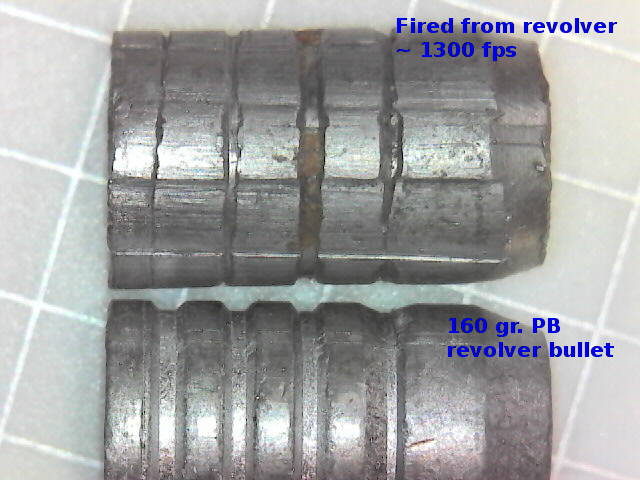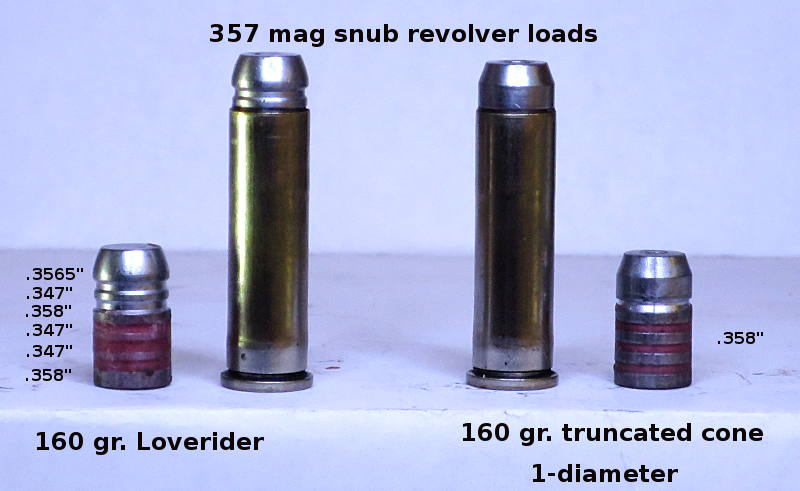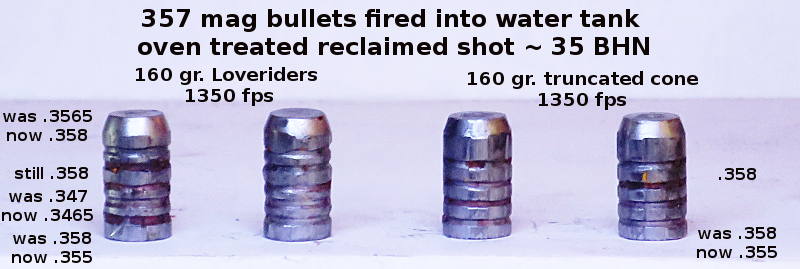A couple years back I fired my standard 357 revolver load into a water tank and noticed that the lube grooves were nearly wiped out -- not as severe as Brad's bullet, but enough to be concerned. Also the bullet seemed to engrave / smear more on one side than the other. The grooves survived much better when the same load was fired from a rifle (same 0.358" groove diameter, by the way). I wondered if the "Paradox effect" was to blame for smearing the revolver bullet's grooves? If so, a Loverider design might help. Note that those oven treated COWW bullets were about 10 years old at the time so their BHN was probably only 19 - 21.
Despite the severe damage to the grooves and the uneven engraving, that load was a good shooter by snub standards, averaging 5 shots into 5" or better at 50 yards when I did my part.
For today's experiment, both the old standard truncated cone bullet and the experimental Loverider bullet were cast of J.R. brand reclaimed shot, sized 0.358", oven treated at 470F, lubed with BAC in an oversize die, then seated on top of my usual load of 18.2 gr. WW296, ignited by a Winchester magnum small pistol primer. They clocked 1350 fps, about 25 - 50 fps faster than usual, perhaps due to the 35 BHN alloy instead of the 21 - 25 BHN COWW alloy that I used in the past.
(Yes, that's a hot load; Quickload puts it at 45,000 psi, and pressures can rise quickly when you push WW296 that hard. I'll have to drop the powder charge if I'm going to use reclaimed shot instead of COWW. The SAAMI 35,000 psi spec is pretty tame, and I'm comfortable pushing low 40's in a strong gun like the Ruger, but there's no point in overdoing it since you don't gain much additional velocity, anyway.)
Perhaps thanks to the 35 BHN alloy, all the grooves on both bullet designs survived the water tank. One side of the bullet still engraved a little deeper than the other, but the difference is slight and you wouldn't notice it if you didn't examine the bullet carefully. It's conceivable that the uneven engraving is due to cylinder/barrel misalignment, a common condition on mass produced revolvers, or the "Paradox effect" could be slapping the bullet around in the forcing cone and pushing it to one side. Either is possible.
The base of both bullets somehow shrank to about 0.355". The base had a scoured appearance and I'm guessing that the shrinkage is due to water scouring the base in the water tank, but I can't rule out something happening to the base in the barrel.
The Loverider's front band gained diameter, perhaps due to a mild Paradox effect as it was slapped by the forcing cone?
The Loverider's lower two bore riding bands seem to shrink 0.0005". That also could be due to a mild Paradox effect. The upper bore riding band remained 0.347".
You can't tell from this photo, but both bullet designs "skidded" slightly on the front band, normal for magnum revolver loads and nothing to be concerned about. Despite having much less groove diameter bearing area, the Loverider did not skid any more than the truncated cone design. That suggests to me that not much bearing area is required to grip the rifling.
What did this little experiment prove? So far it seems to prove that 35 BHN bullets resist deformation better than 19 - 21 BHN bullets.

I like hard bullets.

I haven't tested the Loverider on paper yet. It's been 11 years since I shot a revolver to any extent, so I'm rusty and my bench has not yet been set up for a revolver, so it may take me a while to dial in the powder charge and see how the Loverider does in the accuracy department.






